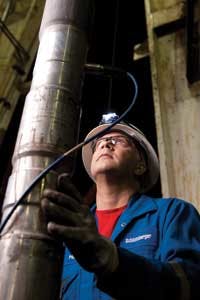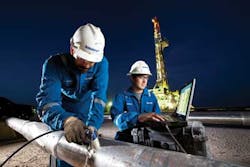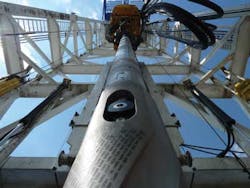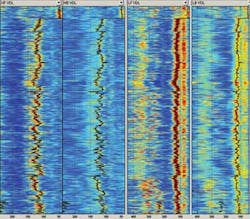Logging-while-drilling technology continues to reduce drilling risk
Dick Ghiselin
Special Correspondent
When logging-while-drilling (LWD) made its debut in the late 1980s, several advantages were touted. Chief among these was the potential elimination of wireline logs. In addition, it was postulated that LWD tools arrived at target formations only a few minutes after they had been penetrated by the bit, thus avoiding, for the most part, invasion of mud filtrate that might flush hydrocarbons away from the sandface.
But early LWD log quality, resolution and depth accuracy were not up to the same level of that offered by popular wireline logs that were in use at the time. LWD telemetry bandwidth limited real-time transmission of log data. That was then.
Today, modern LWD logs rival their wireline counterparts in most categories. New tools measure nearly every formation parameter with comparable precision. Telemetry bandwidth has been boosted, and downhole processing has reduced the amount of data so decision-critical information is available to the logging engineer in real time.
As the perceived value of LWD/MWD data escalated, operators who once were not satisfied by the cost have come increasingly to accept that the cost is more than offset by the value of timely drilling and reservoir information. As more extended-reach wellbores are constructed, operators are not comfortable extrapolating formation information from vertical pilot holes that could be thousands of feet away. They demand accurate data in these wellbores. This has leveled the playing field for LWD versus wireline. The ability to reduce risk and steer wellbores precisely into formation sweet spots transcends the cost in many cases.
Delivering quantitative solutions
Akshay Sagar, Global Business Development Manager for Schlumberger Drilling & Measurements, explained his company's position. "Schlumberger is committed to delivering quantitative solutions through high quality measurements using a complete portfolio of formation evaluation services supported by geographically dispersed centers strategically located worldwide with highly skilled technical experts to support these services." He continued: "Two new measurements have been launched to kick off an aggressive campaign of new technology introduction—the NeoScope sourceless formation evaluation while drilling service and the MicroScope resistivity- and imaging-while-drilling service," he said.
Both new members of the Scope family of LWD services provide formation evaluation for various targeted applications. The NeoScope tool is the first system able to provide a comprehensive multi-function formation evaluation without a chemical radioactive source. Using a unique application of nuclear physics, the high-energy electronic neutron generator provides 2.5 times deeper reading formation density, neutron porosity, Sigma, and elemental spectroscopy with repeatable accuracy. Interpretation of the resulting logs benefits from a new algorithm that translates data into actionable information in real time.
The MicroScope service helps in accurate formation evaluation and well placement in reservoir sweet spots. Operating equally well in clastics and carbonates, it maps natural fracture networks to support the completion design. Recently, in China, the tool maintained 91% coverage in a 3 ft to 7 ft (1 m to 2 m) thin dolomite bed over a 3,600-ft (1,095 m) lateral despite numerous faults and dip variations.
"The new services work well in combination with other members of the Scope Family of LWD services in the respective hole sizes," said Sagar. "NeoScope is especially useful in countries with strict rules that limit transportation of traditional radioactive sources," he explained. "Also, in high risk areas, such as deepwater, customers no longer risk losing a radioactive source in the hole and all the mandatory and costly procedures that accompany such incidents." The added reliability is paying off.
Obtaining essential information
Baker Hughes has replicated most of the features of its popular Reservoir Characterization Instrument (RCI) in the new FASTrak LWD fluid analysis sampling and testing-while- drilling service. This new service is capable of making an unlimited number of pressure and fluid analysis tests; it can also capture and recover up to 16 fluid samples under pressure-volume-temperature (PVT) conditions. The advantages of taking samples while drilling include obtaining a higher quality sample with less contamination, and reduced pump-out times due to less invasion of the drilling fluid into the newly drilled reservoir. Combined, this results in better samples at a reduced overall cost. This service was developed to help gather formation pressure data and samples in environments that cannot be tested with wireline tools, such as in highly deviated or extended-reach wells.
In addition to the RCI-type sensors, the new LWD sample service offers automatic sequencing during pressure testing, pump-through operations and sampling. During these operations, quality data bits are sent up to the surface to ensure everything is going according to plan.
The new LWD sampling service offers SmarTest optimized pressure testing, as employed by the Baker Hughes TesTrak formation pressure-while-drilling service. The SmarTest feature, vital in determining fluid pressure and mobility, is performed automatically, and the test parameters are monitored by the engineer at the surface. Subsequently, the tool selects the optimum pre-test and prepares to take a sample on the command of the engineer.
During the FASTrak clean-up activity, fluid is pumped through the tool where it is analyzed in real time and its degree of contamination is assessed by the engineer before a sample is captured. Contaminated fluid is pumped through the tool and back into the mud column. Only when the contamination level is acceptable will a sample be captured. Among the fluid parameters continuously measured are viscosity, pressure, temperature, sound velocity, density, and refractive index. Calculations of compressibility and the gas-to-oil ratio (GOR) are also performed during the fluid clean-up stage.
Seal integrity is maintained automatically using the unique SmartPad feature. When the tool sets, it adjusts its setting pressure to maintain a seal. If during the course of the test the sealing pressure bleeds down below a certain threshold, the pump automatically initiates to restore and maintain the required sealing pressure. If the probe reaches full stroke and sealing pressure continues to bleed, a potential loss-of-seal warning is sent to the engineer so no time is wasted.
The potential of the tool becoming stuck is minimized because it is designed so the rig can maintain circulation the entire time the tool is set. To take advantage of this, Baker Hughes engineers have equipped the tool with a mud turbine to generate the necessary electrical power to operate the tool. Since the tool activities are electro-mechanical rather than hydraulic, they were designed to be simpler and more robust with greater reliability, and under a wide range of environmental conditions.
The LWD system uses the same single-phase sample tanks as in the RCI wireline tool. To ensure single-phase samples are obtained, the test tanks are pre-charged with nitrogen to keep the samples above their bubble points. After 450 cc to 830 cc samples are taken, the pump over pressures the tank before it is sealed to ensure the sample is maintained above the bubble point. Filled test tanks are approved by the US Department of Transportation for air, land or sea transport. A unique optical field analysis can be made to ensure the tank contains a representative sample before it is transported.
This service has acquired wireline-quality measurements in extremely challenging borehole environments. In Europe, an operation was performed in a 4,287 ft (1,307 m) tangent section at 73° inclination. The service accurately measured gradient quality formation pressures and collected six oil, two water, and three gas samples.
High-fidelity rock music
Halliburton has doubled down on its Bimodal AcousTic (BAT) tool success by launching the QBAT multipole LWD sonic tool. With significant design improvements, the new tool helps deliver accurate shear and compressional velocity measurements in a wider range of formation types than its predecessor. Very soft formations, like those often found just beneath the mudline in deepwater wells, are targeted by the QBAT sensors, and the tool provides geomechanics and wellbore stability parameters for determination of rock mechanical properties that are essential for successful completion designs.
Fourteen wideband piezoelectric receivers form an array that has an improved upper limit of slow shear measurement of over 600 μsec/ft; this is at least 50% better than previously possible. The receivers are much less sensitive to drilling noise and have a much wider frequency response than standard ones. When coupled with four tunable axial transducers, positioned at 0°, 90°, 180°, and 270° around the collar's circumference, the combination delivers monopole, dipole, and quadrupole measurements under noisy drilling environments and/or poor borehole conditions. Translating tool description to delivered wave types, this means the tool can acquire Stoneley, flexural, and screw waves for comprehensive acoustic interpretations that include synthetic seismograms and amplitude variation with offset (AVO) reconciliation. The ability to tune the transducers allows the engineer to optimize the frequency to match the resonant frequency of each formation being drilled for higher quality compressional and shear-wave detection. Shear wave velocity is more accurate because of simultaneous multipole inversion, paying off in demanding borehole conditions.
The tool has numerous applications. Besides traditional outputs like formation porosity, the tool can provide a cement bond indicator and determining cement top of surface or intermediate casing as the tool string traverses the upper portion of the hole. It has the high resolution to identify natural fracture swarms and evaluate them for possible subsequent completion decisions. And it can discriminate the presence of gas in the formation using Vp/Vs ratios.
Available in 4.75-in., 6.75-in., 8-in., and 9.50-in.sizes, the QBAT tool is compatible with all Halliburton LWD tools so custom configurations can be specified. The 8-in. size is also available in a high-flow version with 25% greater flow diameter. This doubles the maximum mass mud-flow rate to 20,000 lbm/min over the standard 8-in. size. A major benefit of the new acoustic configuration is a significant boosting of signal-to-noise ratio which overcomes drilling noise that often compromises sonic measurements.
Big bang sonic tool
Weatherford's ShockWave sonic tool addresses the industry need for reliable, real-time access to reservoir information while drilling. The tool provides high-quality sonic data continuously. According to Mohamed Diab, Weatherford ShockWave Sonic Product Champion, "We chose an LWD design to provide maximum benefit to the driller. A high-quality signal delivered from an LWD tool removes the need to run a separate wireline sonic tool, saving money and time," he explained.
The essence of the new tool was to create a device that would maximize formation signals while minimizing drilling noise events. The goal of the design group was to develop a high-accuracy downhole measurement to deliver real-time data under any drilling conditions. The team was aided by the initial development of a software modeling program that allows them to test and qualify designs of individual tool components and the entire tool itself on paper, eliminating the need to build and test prototypes. A key objective was to design effective sound isolation between the tool transmitter and its receivers while maintaining strength of the drill collar.
Diab elaborated: "Our transmitter enables a high-strength signal that can be easily differentiated from the drilling noise associated with the LWD environment. It provides good signal directionality to focus the signal into the formation with nominal sonic energy being transmitted to the tool body." Diab continued to explain how engineers and scientists were able to design and test several transmitter/receiver concepts to achieve maximum signal-to-noise ratio. The final transmitter design delivers about 0.87 psi of pressure which is 50% more than the tool's wireline counterpart. He claimed the LWD transmitter output was two to three times greater than that of conventional LWD sonic devices in the industry. The design is scalable, and can be configured to fit different collar sizes as needed. Currently 6.75-in. and 8.25-in. tools are available with other sizes under development. The tough ShockWave sonic tool has pressure and temperature ratings of 30,000 psi and 329°F (165°C) respectively.
The receiver array has high sensitivity in the axial direction and low sensitivity in the radial direction making it particularly sensitive to formation signals and less sensitive to collar signals or mud flow noise. Receivers are acoustically isolated from the collar to minimize direct coupling of transmitted signals through the collar. Processed data is available in the field within a few hours after the bit run.
Successful applications have been achieved in the Gulf of Mexico, the North Sea the Middle East and China. In the North Sea, a particularly challenging job required logging through 9 5/8-in. casing. According to Diab, the tool correctly identified the casing and presented a continuous compressional sonic log of the formation behind the pipe.
Continuous technical improvements
Over a period spanning three decades, the capabilities and quality of LWD solutions has steadily increased. LWD tool strings have played an enabling role in all the recent world record extended reach drilling (ERD) wells and in the world's ultra deepwater discoveries. Today, the providers of modern LWD tool strings can truly live up to the promise made decades ago. "If the drillers can drill it, we can log it."





